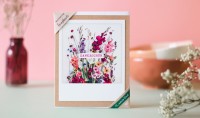
We encounter postcards in a wide variety of shapes and colours. Whether with classic travel motifs or unusual illustrations and sayings – the cards are as varied as their ways to us and the people from whom we get them. But the cards always have one thing in common: they trigger a certain feeling in us. And that has been already so for many years.

The first forerunners of the postcard could already be dated to the 15th century, even if they had little in common with today’s postcard. At that time there were small cards with Christian motifs, which were given with spoken congratulations on New Year’s Day. At that time it was not yet possible to send such cards, so they were given personally.

Source: Wikimedia
In the 18th century, the nobility and bourgeoisie in France developed the custom to exchange business cards, which with time were also provided with visual decorations, while in England another custom developed: pre-printed cards for Valentine’s Day with illustrations and special embossing for the lady of the heart.
Sometime later, in the 19th century, a general custom began in Germany to insure friendship and affection with small pictures and so-called “jewellery cards”. It almost sounds like our PICKMOTION cards, even if it is still a little early for that. The postcard itself did not yet exist, but the use of pictures and illustrations was used more and more in correspondence. The first local publishers in bathing and travel locations began to sell letterheads with city views.

Source: PrintRunner
The first real postcard was sent and received in 1840 by the writer Theodore Hook in Fulham (London). He sent it to himself, and this was probably intended as a little amusement since the card showed a caricature of the postal workers.
The idea of the postcard, although at that time under other names, then spread in the 1860s. First in the USA (a law was passed here as early as 1861 that allowed privately printed cards weighing less than one ounce to be sent by post) and then a little later in German-speaking countries, where the “Drucksachenkarte” was introduced and nowadays can be seen as a preliminary step to the postcard – it was only approved for printed texts (advertisements, business advice, price courante), was officially called “open card” and, apart from the recipient, sender and date, as well as the signature, no handwritten additions were allowed. On October 1, 1869, the “Correspondence Card” was introduced for the first time in Austria-Hungary, in Germany, it came on the market in 1870. The postcard, which still exists today, got its name in 1872 – at that time it could only be sent nationally. Three years later, it was also approved for international shipping. The birth of the international success of the postcard.
For more than 30 years, the front of the postcard was intended for the address and the back for text or images. It was not until 1905 that the card with its current arrangement of elements with text and address on the back was introduced.
Over the years, an incredible variety of shapes and materials developed, whereby the standard format for postcards of 14.8 x 10.5 cm known today was introduced on October 1, 1927. Today there are postcards with jagged edges, in heart format or vary from landscape to 360-degree panorama format – every kind of shape exists, and also with the material many experiments have been carried out.

Source: suck.uk
The postcard had its best times between 1885 and the end of the First World War in 1918. Billions of postcards were sent out annually during this period. According to Deutsche Post, today’s figures are in the three-digit million range, a third of them are sent in the summer months. The shipping figures show on the one hand that postcards are still very popular, and on the other hand that despite the increasing digitalization, they are still part of the holiday for most people.
But not only the classic holiday greeting can be sent with the cards. Already back then, when the postcard had found its way into private life, special cards for festive occasions quickly developed. From wedding cards to birthday cards, from Christmas cards to funeral cards and general greeting cards that are available today for every kind of occasion. And finally, the more festive variant of the double card (or folding card) emerged, which is sent like a letter in an envelope.
And this is how we come to us and our PICKMOTION postcards: fantastic photography, good vibes for the little, special moments in life and a freshly printed, good feeling in your hands to bring joy to yourself and your loved ones – very similar to the “jewellery cards” at the beginning of the 19th century, just 200 years later.






